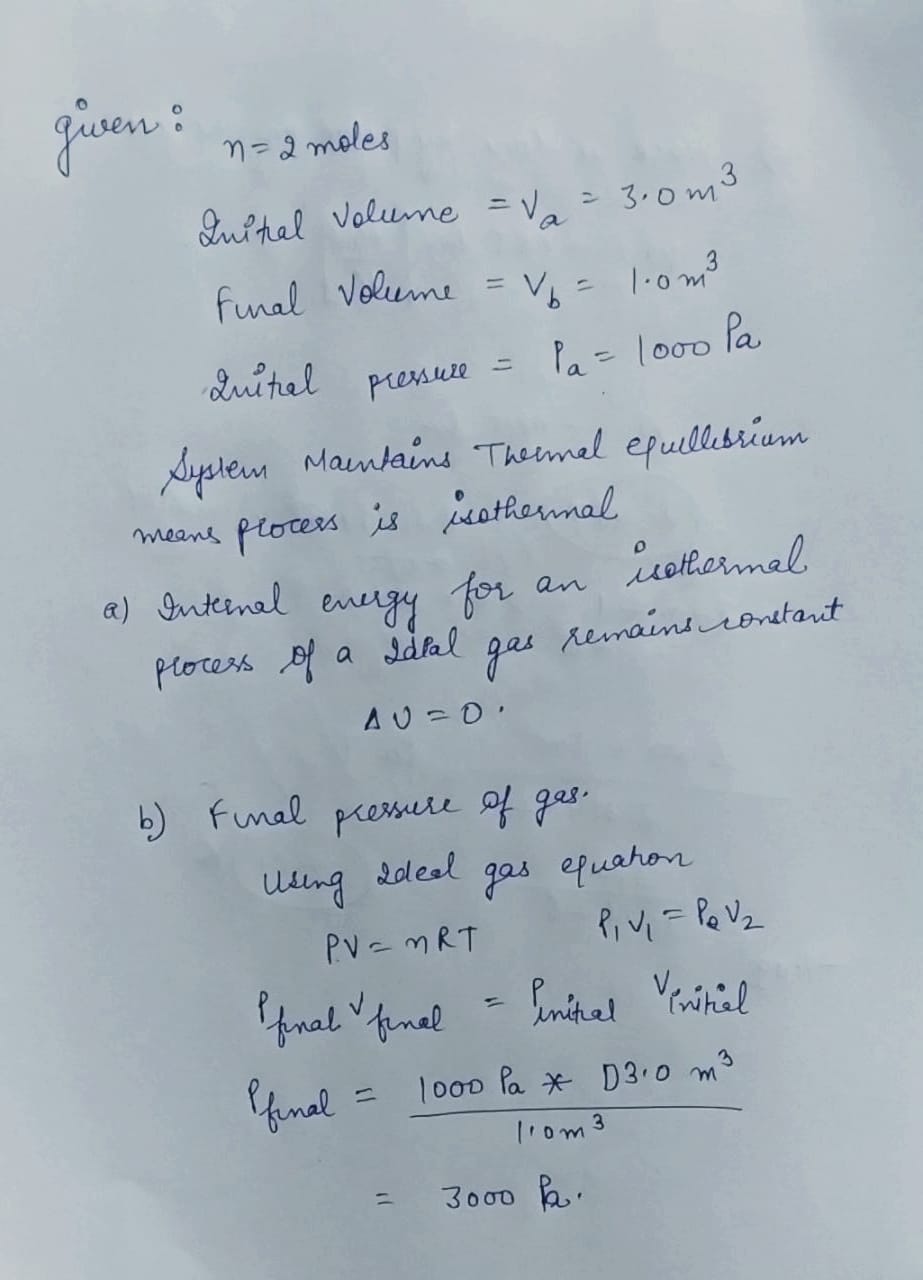P (Pa) Q3) Thermodynamic Processes-2.0 mol of a diatomic ideal gas undergoes a process in which it is compressed very slowly from state a (V. = 3.0 m³, P, = 1000 Pa) to state b (V, = 1.0 m), in such a way that the system maintains thermal equilibrium with its surroundings at all times. 3000 2000 A. Find the change in internal energy during the proces. 1000 B. Find the final pressure of the gas. 0 1 2 3 4 V (m') C. Find the work done by the piston on the gas during this process. (Hint: Since Pis not constant during this process, it doesn't come out of the integral. Use the ideal gas law to find an expression for Pin terms of constants and the integration variable K)
P (Pa) Q3) Thermodynamic Processes-2.0 mol of a diatomic ideal gas undergoes a process in which it is compressed very slowly from state a (V. = 3.0 m³, P, = 1000 Pa) to state b (V, = 1.0 m), in such a way that the system maintains thermal equilibrium with its surroundings at all times. 3000 2000 A. Find the change in internal energy during the proces. 1000 B. Find the final pressure of the gas. 0 1 2 3 4 V (m') C. Find the work done by the piston on the gas during this process. (Hint: Since Pis not constant during this process, it doesn't come out of the integral. Use the ideal gas law to find an expression for Pin terms of constants and the integration variable K)
Chemistry
10th Edition
ISBN:9781305957404
Author:Steven S. Zumdahl, Susan A. Zumdahl, Donald J. DeCoste
Publisher:Steven S. Zumdahl, Susan A. Zumdahl, Donald J. DeCoste
Chapter1: Chemical Foundations
Section: Chapter Questions
Problem 1RQ: Define and explain the differences between the following terms. a. law and theory b. theory and...
Related questions
Question

Transcribed Image Text:Q3) Thermodynamic Processes- 2.0 mol of a diatomic ideal gas
undergoes a process in which it is compressed very slowly from
state a (V. = 3.0 m³, P, = 1000 Pa) to state b (V, = 1.0 m³), in
such a way that the system maintains thermal equilibrium with
its surroundings at all times.
P (Pa)
3000
2000
A. Find the change in internal energy during the process.
1000
B. Find the final pressure of the gas.
1
3
4 V(m³)
C. Find the work done by the piston on the gas during this process. (Hint: Since Pis not constant during this process,
it doesn't come out of the integral. Use the ideal gas law to find an expression for Pin terms of constants and
the integration variable V)
D. So what's the work done by the gas on the piston during this process?
E. How much heat – if any - was transferred between the gas and surroundings during this process? Did heat
flow from the gas to the surroundings or from the surroundings to the gas? Explain your reasoning.
F. At the end of the process, is the average kinetic energy per molecule greater than, less than, or the same as the
average kinetic energy per molecule at the beginning of the process? Explain your reasoning.
G. Represent this process ab as accurately as possible on the PV diagram above.
Expert Solution
Step To calculate Change in internal energy during the process and final pressure of the gas

Trending now
This is a popular solution!
Step by step
Solved in 2 steps with 3 images

Knowledge Booster
Learn more about
Need a deep-dive on the concept behind this application? Look no further. Learn more about this topic, chemistry and related others by exploring similar questions and additional content below.Recommended textbooks for you

Chemistry
Chemistry
ISBN:
9781305957404
Author:
Steven S. Zumdahl, Susan A. Zumdahl, Donald J. DeCoste
Publisher:
Cengage Learning

Chemistry
Chemistry
ISBN:
9781259911156
Author:
Raymond Chang Dr., Jason Overby Professor
Publisher:
McGraw-Hill Education

Principles of Instrumental Analysis
Chemistry
ISBN:
9781305577213
Author:
Douglas A. Skoog, F. James Holler, Stanley R. Crouch
Publisher:
Cengage Learning

Chemistry
Chemistry
ISBN:
9781305957404
Author:
Steven S. Zumdahl, Susan A. Zumdahl, Donald J. DeCoste
Publisher:
Cengage Learning

Chemistry
Chemistry
ISBN:
9781259911156
Author:
Raymond Chang Dr., Jason Overby Professor
Publisher:
McGraw-Hill Education

Principles of Instrumental Analysis
Chemistry
ISBN:
9781305577213
Author:
Douglas A. Skoog, F. James Holler, Stanley R. Crouch
Publisher:
Cengage Learning

Organic Chemistry
Chemistry
ISBN:
9780078021558
Author:
Janice Gorzynski Smith Dr.
Publisher:
McGraw-Hill Education

Chemistry: Principles and Reactions
Chemistry
ISBN:
9781305079373
Author:
William L. Masterton, Cecile N. Hurley
Publisher:
Cengage Learning

Elementary Principles of Chemical Processes, Bind…
Chemistry
ISBN:
9781118431221
Author:
Richard M. Felder, Ronald W. Rousseau, Lisa G. Bullard
Publisher:
WILEY